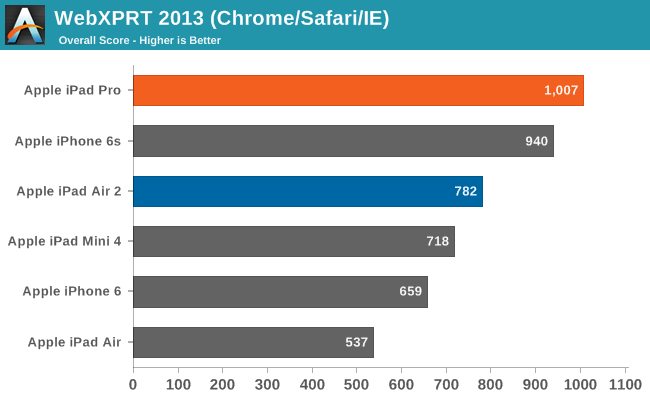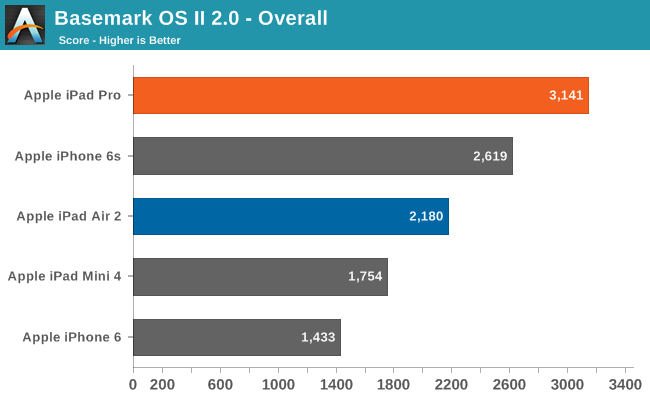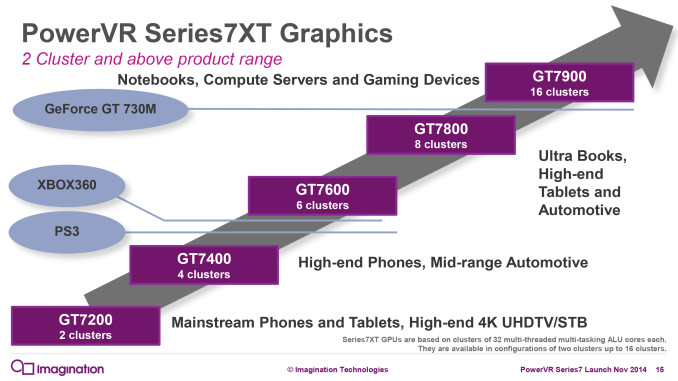The iPad Pro Preview: Taking Notes With iPad Pro
by Joshua Ho & Ryan Smith on November 11, 2015 7:00 AM ESTThe A9X SoC & More To Come
Finally, as everyone is undoubtedly eagerly anticipating our look at the A9X SoC inside the iPad Pro, let’s take a very quick look at what we know about the SoC so far. There’s a bit of a limit to what we can do blindly via just software, but I’m hoping that the eventual A9X die shots will confirm some of our suspicions on A9X’s configuration.
| Apple SoC Comparison | ||||||
| A9X | A9 | A8X | A6X | |||
| CPU | 2x Twister | 2x Twister | 3x Typhoon | 2x Swift | ||
| CPU Clockspeed | 2.26GHz | 1.85GHz | 1.5GHz | 1.3GHz | ||
| GPU | PVR 10 cluster Series7? | PVR GT7600 | Apple/PVR GXA6850 | PVR SGX554 MP4 | ||
| RAM | 4GB LPDDR4 | 2GB LPDDR4 | 2GB LPDDR3 | 1GB LPDDR2 | ||
| Memory Bus Width | 128-bit | 64-bit | 128-bit | 128-bit | ||
| Memory Bandwidth | 51.2GB/sec | 25.6GB/sec | 25.6GB/sec | 17.1GB/sec | ||
| L2 Cache | 3MB | 3MB | 2MB | 1MB | ||
| Manufacturing Process | Unknown (TSMC 16nm or Samsung 14nm) |
TSMC 16nm & Samsung 14nm |
TSMC 20nm | Samsung 32nm | ||
First and foremost, the most unexpected news here is that unlike A8X, A9X is not packing a triple-core CPU. Instead A9X drops back down to just a pair of Twister CPU cores. The twist here is that relative to A8X and A9, Apple has cranked up their CPU clockspeeds. Way, way up. Whereas the iPad Air 2 (A8X) shipped at 1.5GHz and the iPhone 6s (A9) at 1.85GHz, the A9X sees Apple push their clockspeed to 2.26GHz. Not counting the architectural changes, this is 22% higher clocked than the A9 and 51% higher than the A8X.
The fact that Apple dropped back down to 2 CPU cores is unexpected given that we don’t expect Apple to ever go backwards in such a fashion, and while we’ll never know the official reason for everything Apple does, in retrospect I’m starting to think that A8X was an anomaly and Apple didn’t really want a tri-core CPU in the first place. A8X came at a time where Apple was bound by TSMC’s 20nm process and couldn’t drive up their clockspeeds without vastly increasing power consumption, so a third core was a far more power effective option.


By comparison, with the FinFET process Apple is using here – and given the lower volume of A9X I don’t have reason to believe it’s dual-sourced, so it’s either TSMC or Samsung – Apple has been free to increase their clockspeeds substantially. At the same time these FinFET processes are still new and yields won’t be great, so there is a strong incentive to keep die sizes down to keep yields up, and adding a third core would only make that harder. If I had to guess, Apple only wanted two cores to begin with – this makes it easier for developers knowing that they only have two cores to work with – and that it’s A8X that is the anomaly.
Otherwise a highly clocked CPU is far more in-line with Apple’s design philosophy as it means that A9X is capable of amazing single-threaded performance – and keep in mind that we’re talking ARM Cortex-A57-like clockspeeds for a CPU that gets much more work done per cycle – so what we see here makes a lot of sense. Plus with iPad Pro in particular Apple has more battery capacity to sustain the power draw of a higher clocked SoC, and more surface area to dissipate that heat, so the usual concerns about power and cooling aren’t quite as pressing. I do wonder if this will impact multitasking performance much, but given what Twister is capable of, I’m not nearly ready to write off a dual-core Twister implementation clocked this high.
Moving on, as is customary for the X-series SoCs from Apple, A9X features what I believe to be a wider 128-bit LPDDR4 memory bus. The memory bandwidth numbers clearly point to a wider bus, and Apple needs the bandwidth to feed a more powerful GPU.
| Geekbench 3 Memory Bandwidth Comparison (1 thread) | ||||||
| Stream Copy | Stream Scale | Stream Add | Stream Triad | |||
| Apple A9X 2.26GHz | 20.8 GB/s | 15.0 GB/s | 15.3 GB/s | 15.1 GB/s | ||
| Apple A8X 1.5GHz | 14.2 GB/s | 7.44 GB/s | 7.54 GB/s | 7.49 GB/s | ||
| A9X Advantage | 46.4% | 101% | 103% | 102% | ||
Which brings us to the last bit of our preview, the GPU. Apple went with a 6 cluster PowerVR Series7 design on A9, and for A9X they have gone with a larger design. Without a die photo it’s basically impossible to determine how many clusters are in use since clockspeed plays such an important role. What we do know is that GPU performance relative to A9 has pretty much doubled, which once again is right in-line with Apple’s usual design goals.

Given what Apple has done with clockspeed on Twister, for the moment I am staking my bet on it being a 10 cluster design with a higher GPU clockspeed than A9 giving us the rest of the performance boost. To be clear here this could also be a 12 cluster design at a similar clockspeed or even an 8 cluster design clocked far higher – we’ll need die shots to confirm – but given all of the options it’s a 10 cluster design that is the best balance between die size and clockspeed, and it would also be the biggest curveball Apple could throw. It should also be noted that PowerVR Series7 certainly supports such a configuration since it’s scalable from 2 to 16 clusters, although in Imagination’s official product catalog they don’t have a name for such a configuration. So for the moment I’m simply calling it a 10 cluster Series7.
Anyhow, we’ll be back later with a full review of the iPad Pro, including the pros and cons of Apple’s first large-format, productivity-oriented tablet, and a full breakdown of the A9X SoC. So until then stay tuned.











199 Comments
View All Comments
nikon133 - Thursday, November 12, 2015 - link
Size of what...?If someone wants to use Surface as one's main work machine, there is hardly an excuse why it wouldn't be with Surface's docking station... which will allow for 2 desktop screens, USB3.0-attached storage (or anything USB/NAS/SAN over lan), wired network. We barely have laptop users who don't use docking stations in the office, save for handful of very small setups - essentially on-man bands... recommendation does transfer to Surface users, and it does work well.
Our Surface users are not suffering any handicap over desktop users, for huge majority of cases. I mean, we will not recommend Surface (docked or not) for graphics designers, but for anyone who does common office tasks on their machines, there is no handicap. There is, however, benefit of having machine more portable than average laptop, and also capable to replace tablet. Sure, it does come with higher price than desktop, but actually competes quite well with laptops nowadays. Here in NZ, we pay for base Elitebook i5/4GB/120GB SSD around NZ$1,500. Surface Pro 3 i5/4GB/128GB SSD with keyboard and extended 3 years warranty (to match Elitebook) is NZ$1,420.
cbf - Wednesday, November 11, 2015 - link
You don't say what you do on your laptop. If it's serious content creation -- be if CAD, Adobe Creative Suite, or even Office, I think it will be quite a while, if ever, before the iPad Pro can match the level of productivity that you get with a full desktop OS.If you haven't looked at a Surface yet, you should get yourself someplace where you can examine the whole product line (the 3, 4 Pro, and Book). A comparably equipped Surface Pro 4 is actually cheaper than an iPad Pro once you include the stylus & keyboard.
Wineohe - Thursday, November 12, 2015 - link
Yes, thanks, you are supporting my thinking. At what point does a tablet try to be something it's not, at least from a price perspective. The iPad Pro is something very few people asked for. The Notes application should run on any newer iPad. Of course if money is no object then spend away on a large, overpriced, limited functionality tablet. Otherwise I think a Surface or the like makes far more sense. My own needs will be Office and the occasional Lightroom use while traveling, and of course email and surfing.The Tablet and Laptop concepts have merged, but they forgot to tell Apple. Instead they just gave us a larger more expensive iPad. Generous and genius at the same time.
kirsch - Wednesday, November 11, 2015 - link
> To do this, I took the iPad Pro to class and simply relied on the built-in Notes application to try and see how well I could follow along in lectures and discussions.What? They let you take the unreleased iPad Pro still under embargo to class???
melgross - Wednesday, November 11, 2015 - link
Once they show it do us in the introduction, it's not as much of a concern. They're in the stores already, so people have been playing with them there.Mondozai - Wednesday, November 11, 2015 - link
"To do this, I took the iPad Pro to class"TIL: Joshua Ho is very popular in his classes and probably has to deal with a lot of new-found "friends" who are all of a sudden extremely interested in befriending him(and getting to see new, unreleased Apple hardware in the process).
Good preview, Josh, looking forward to reading the full one.
On a sidenote, the pace on this website has truly picked up after being in the doldrums for a while. KUTGW!
JoshHo - Wednesday, November 11, 2015 - link
UCLA is a big place. If no one is next to you then it's pretty hard for anyone to see anything, especially when iPads and Surface Pros are common sights in classrooms. :)kmmatney - Wednesday, November 11, 2015 - link
I went to UCLA for my engineering B.S. and M.S. degrees. I still don't see what is wrong with using a pen and multi-subject notepad. You can write as fast as you want, and it's easy to make amendments, etc... At least it worked for me (still does, in fact). It just seems like taking notes has gotten more complicated than it needs to be.lmcd - Wednesday, November 11, 2015 - link
Unless you're an absent-minded person that loses paper notebooks and loose-leaf with ease. Then it's simpler than ever.zeeBomb - Wednesday, November 11, 2015 - link
That's interesting haha. If I was there I would walk out to Josh and say: "Hey man, love your reviews. But uh, can you give me a little shoutout on your next article?" haha.